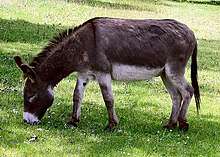Donkey-hide gelatin
Donkey-hide gelatin or ass-hide glue (Latin: colla corii asini) is gelatin obtained from the skin of the donkey (equus asinus) by soaking and stewing. It is used as an ingredient in the traditional medicine of China,[1][2] where it is called ejiao (simplified Chinese: 阿胶; traditional Chinese: 阿膠; pinyin: ē jiāo).

The gelatin is produced in several coastal provinces of China: Jiangsu, Zhejiang, Shandong. Shandong's Dong'e County was where "ejiao" got its name.
According to a ca. 1723 account by the French Jesuits Dominique Parrenin, there was a well in Dong'e which was normally kept closed and sealed, and which was only opened when water was taken to be used in preparation of ejiao for the emperor's court.[3]
Manufacture
According to Parennin, the product was traditionally prepared during the late fall and winter (from after the harvest and until the beginning of March). It was supposed to be made from the skin of a recently killed well-nourished black donkey.[3] Since the supply of this material was rather limited, it was said that a large amount of "fake" ejiao was also manufactured, using skins from mules, horses, camels, pigs, and sometimes, it was said, even from old shoes; a bit of "real stuff" was added to it, to deceive consumers.[3]
Ejiao is either prepared as dry gelatin or mixed with powdered oyster shell or pollen to form glue balls. It tastes sweet.[1]
Jesuits noted that while the "real" ejiao has no disagreeable taste or smell, the fake product could be distinguished by its unpleasant smell and taste, even when it was made from pig skins (which, supposedly, provided the best approximation of the real thing).[3]
In the 21st century, ejiao manufacturers experience problems with the supply of genuine donkey hides, as fewer people raise these animals these days. The decreasing supply combined with strong demand for ejiao has led to greatly increased prices for donkey hides in China. This trend is also supported by restrictions on importing animal hides from outside the country. Qin Yufeng, the chairman of a major ejiao manufacturer and a member of Shandong's provincial legislature, has advocated for government support for donkey husbandry.[4][5][6]
Donkey thefts and population declines
In the mid-2010s, donkey prices in many places around the world began to rise sharply amid Chinese herbalism demands. Uganda, Tanzania, Botswana, Niger, Burkina Faso, Mali, and Senegal have banned donkey exports to China.[7] In November 2017, eyewitness footage showing baby donkeys being bludgeoned to death with sledgehammers or killed by having their throats cut was released by PETA Asia.[8] In November 2019, The Donkey Sanctuary reported that 4.8 million donkey hides were required to satisfy the global demand for ejiao, resulting in steep declines of donkey populations around the world.[9][10] Donkey populations are declining in the NorthEast of Brazil, due to Chinese demand.[11]
Applications
In China ejiao is a traditional medicine used for different types of illnesses.[12] An amount of 5 to 10 grams may be dissolved in hot water or wine and mixed with other ingredients in the traditional Chinese materia medica or taken alone. It is believed that donkey-hide gelatin treats a variety of conditions such as bleeding, dizziness, insomnia and a dry cough.[1]
Quite a few manufacturers produce an ejiao bar called "Gu Yuan Gao" (固元膏) in Shandong province. Gu Yuan Gao is a bar made up of ejiao, nuts, sesame, Chinese dates and cooking wine.[13] It can also be used as an edible coating for dates, producing another type of snack.
Ejiao is also used for applying di mo, a special paper-like musical reed membrane, to the dizi, a transverse Chinese flute; it dries quickly, holds quite firmly, and is water-soluble, allowing later replacement of di mo.
The molecular basis for its usage in treating anemia has been shown at least in part from the peptidic components combining multiple approaches. The hematopoietic effect of Colla Corii Asini (Ejiao) may benefit cancer patients suffering from myelosuppression due to radiotherapy or chemotherapy.[14]
See also
- Animal glue / Hide glue
References
- Jing-Nuan Wu (2005), An illustrated Chinese materia medica, Oxford University Press, pp. 284–285, ISBN 978-0-19-514017-0
- Xinrong Yang (2003), Encyclopedic Reference of Traditional Chinese Medicine, Springer, p. 168, ISBN 978-3-540-42846-6
- Gobien, Charles Le; Halde, Jean-Baptiste Du; Querbeuf, Yves Mathurin Marie Tréaudet de; Maréchal, Nicolas; Patouillet, Louis (1819), Lettres Édifiantes Et Curieuses, Écrites Des Missions Étrangères: Mémoires de la Chine, Volume 10 of Lettres Édifiantes Et Curieuses, Écrites Des Missions Étrangères, Lettres Édifiantes Et Curieuses, Écrites Des Missions Étrangères (in French) (reprint ed.), J. Vernarel, pp. 479–481 (This is a reprint; the original text was published in the first half of the 18th century. E xian (for Dong'e) and Ejiao are transcribed Ngo-hien and Ngo-kiao, under the transcription system then in use).
- Chin, Josh (2015-02-06), It Behooves China to Subsidize Donkey Industry, Politician Says
- Zhao, Ruixue (2015-02-04), "Donkey industry calls for financial kick from govt", China Daily
- Li, Courtney (2016-12-16), 阿胶价格暴涨一斤5000元 中国"满世界找驴"
- Leithead, Alastair (2017-10-07). "Why are donkeys facing their 'biggest ever crisis'?". BBC News.
- Williamson, Ben (December 12, 2017). "Donkeys Bludgeoned and Their Skin Taken for Traditional Chinese 'Medicine' (Video)". Alternet. Retrieved February 11, 2018.
- Murray, Jessica (2019-11-21). "World's donkeys being 'decimated' by demand for Chinese medicine". The Guardian.
- Lesté-Lasserre, Christa (December 12, 2019). "Chinese trade in hides has led to global donkey massacre". Science. Retrieved January 24, 2020.
- Suarez, Joana (2019-12-11). "Sob a pele do jumento".
- https://www.scmp.com/news/asia/east-asia/article/3039011/chinese-medicine-ejiao-has-left-worlds-donkey-population-crisis
- https://www.thestatesman.com/supplements/8thday/now-its-the-turn-of-the-donkey-1502690917.html
- Wu, Hongzhong; Ren, Chunyan; Yang, Fang; Qin, Yufeng; Zhang, Yuanxing; Liu, Jianwen (April 2016). "Extraction and identification of collagen-derived peptides with hematopoietic activity from Colla Corii Asini". Journal of Ethnopharmacology. 182: 129–136. doi:10.1016/j.jep.2016.02.019. PMID 26911525.